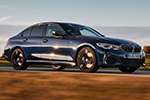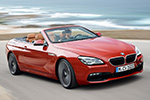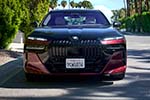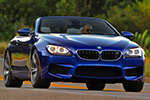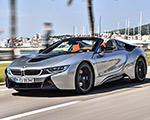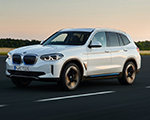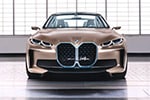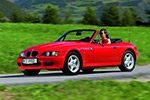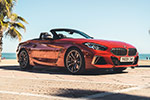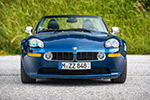The BMW XM was never meant to be a background player. When BMW M decided to build its first standalone model since the M1, the idea was to plant a flag in one of the most profitable corners of the industry: high-performance, high-price SUVs. BMW had been watching this space for years as the Lamborghini Urus exploded in popularity, the Range Rover Sport SV found its groove, and Porsche realized that the Cayenne Turbo GT was basically a license to print money. From the outside, an ultra-M SUV seemed like an obvious move.
BMW didn’t rush the XM. During a recent visit to Designworks in California, it became clear the project had been brewing for a long time. It was meant to be a statement car, something that pushed BMW M into a new category. But even with that preparation, the XM never took off the way BMW hoped.
A Good Start in Sales
It wasn’t a disastrous launch. When it hit the market at the end of Q1 2023, the early numbers were decent. BMW delivered 762 units in Q2, which isn’t bad for a six-figure experiment. Q1 2024 even showed some growth, up 32.3 percent year-over-year to 541 units, helped along by the model finally arriving in the U.S. late in the prior quarter. For a minute, the story looked like it was headed in the right direction.
Then the slide began. Q2 2024 brought a drop of 29.5 percent. Q3 fell another 30.7 percent. And most recently, Q2 2025 saw XM sales sink 23.8 percent to just 409 units. Meanwhile, the rest of the segment kept climbing. Lamborghini sells every Urus they can build. In fact, the brand said they are sold out until 2026. The Range Rover Sport SV remains one of Land Rover’s most in-demand products. So why didn’t the XM connect?
A Controversial Design
Design played a big role. The XM didn’t struggle because it was bold; it struggled because the overall shape never quite settled into something cohesive. The front end grabbed the early headlines, but the real sticking point for buyers was the rear. From some angles it looked muscular, from others it looked inflated and awkwardly tapered. In this price range, proportions matter more than anything. People will buy wild designs, but they need to be visually resolved. The XM always felt like a car with some good ideas that never fully aligned.
The interior faced a different issue. It wasn’t bad — not even close — but it didn’t feel special enough for what the XM was supposed to be. Too much of the cabin looked familiar from the X5 and X6. Yes, the materials were better and the “M Lounge” lighting was interesting, but it didn’t deliver the sense of occasion that buyers expect when they’re spending this kind of money. Walk into a Range Rover SV or a Urus Performante and you know immediately that you’re in something unique. The XM didn’t make that same first impression.
It Needs An Air Suspension. Pronto
Ride comfort didn’t help either. BMW M went with steel springs because they wanted the XM to behave like an M car. Philosophically, that makes sense. Practically, it didn’t. A six-thousand-pound SUV on steel suspension is going to feel firm, and in day-to-day driving the XM could be noticeably stiff. Buyers in this segment want something that can handle corners but also float over broken pavement. Air suspension exists for a reason. Choosing not to use it made the XM feel out of step with what customers expect from a luxury SUV.
A Heavy Beast
And then there’s the weight. At 6,061 pounds, the XM carried more mass than even BMW’s engineers could fully disguise. The plug-in hybrid system added benefits on paper — torque, efficiency, a short electric range — but it also made the SUV feel heavy. The best competitors in this space, especially the Urus and Cayenne Turbo GT, succeed because they feel alive and eager despite their size. The XM could be fast, but it never managed to feel light.
All of this paints a fairly clear picture: the XM didn’t struggle because the concept was flawed. The idea of a BMW M flagship SUV still makes sense. The market is there. The appetite is there. The money is definitely there. The XM stumbled because several key decisions didn’t land with the people BMW needed to impress.
So should BMW try again?
There’s a strong argument for yes, but only if the next attempt starts with a clean sheet. A successor needs a more cohesive design that leans into the clarity and sharpness of BMW’s Neue Klasse direction. It needs an interior that feels genuinely separate from the rest of the lineup — not a nicer X5 M, but something that sits at the very top of the brand in materials, layout, and atmosphere. And it absolutely needs a different mechanical setup.
A lighter, mild-hybrid S68 V8 would solve most of the XM’s dynamic problems. Ditching the full PHEV system would immediately remove at least a thousand pounds. Doing so would give the next-generation model the response and character expected in this segment. All of the top performers rely on combustion power to provide emotional engagement. BMW doesn’t need to chase them, but it does need to match the immediacy and feel if it wants to compete seriously.
There’s also something to learn from the Urus. Not the styling, not the noise, but the attitude. The Urus feels confident, eager, and unashamedly extroverted. Buyers respond to that. The XM, for all its ambition, never radiated that same energy. A successor has to.
Will BMW Build an XM Successor?
The XM’s story is complicated because it was both daring and uneven. BMW swung for the fences, and while the result wasn’t a home run, it wasn’t a total miss either. It was a car that showed where BMW wanted to go but didn’t quite stick the landing. The good news is that the underlying idea remains sound. The SUV that the XM tried to be is still a valid product for BMW M to build. And with the right corrections — better proportions, a more distinct interior, a lighter drivetrain, and a ride that doesn’t punish owners on imperfect roads — an XM successor could be exactly the halo model the brand originally envisioned.
The question now is simple: does BMW want to take another shot? If they do, there’s no reason the second attempt can’t be the one that finally hits the mark.










































